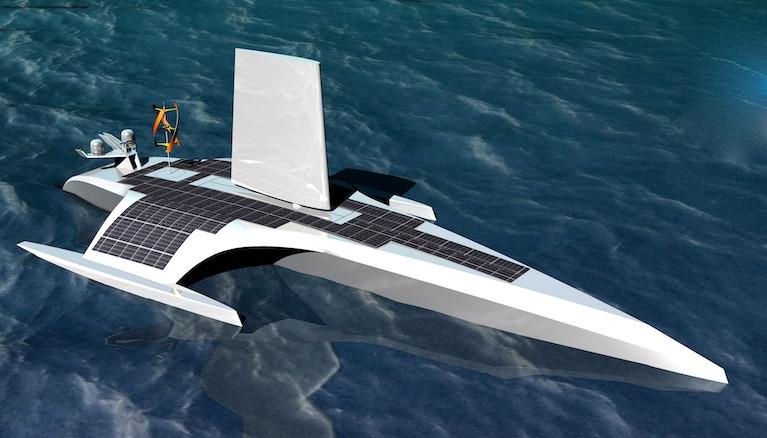Today (Wednesday) in Plymouth in England, the Mayflower Autonomous Ship is expected to have her official launch, though the word is she has been test floated in advance. If that's the case, it was a prudent move, for although un-manned ships using Artificial Intelligence and other technologies have been ideas in the making for some time, this particular 15-metre trimaran – called Mayflower in honour of the 400th Anniversary of the Pilgrim Fathers' voyage in the original Mayflower from Plymouth in Devon to what became Plymouth in Massachusetts – is really pushing the envelope in just about every direction, as she will be reliant on AI, solar power and the auxiliary support of a wing sail to get her alone across the Atlantic.
Built in Gdansk in Poland for a partnership which includes ProMare and IBM, this 50-footer was originally supposed to have been launched at the beginning of the summer and to be starting her voyage around now, after extensive sea trials. But the pandemic has delayed everything, and the pioneering Transatlantic voyage is currently planned for early next summer after trialling through the winter.
Building the Mayflower Autonomous Ship in Gdansk
This may be no bad thing for the promoters of the project, as the western side of the North Atlantic at the moment is experiencing the most active tropical storm and hurricane-generating conditions ever recorded. Doubtless, we'll be feeling the effects of that in Ireland in due course, but right now the idea of sending a slip of a thing directly to America ultimately relying on solar power on a northern route re-tracing the original Mayflower's course of 1620 might well prove to be a test too far.
 Ghost from the past. The two Mayflowers: the original took 66 days to get across the Atlantic in 1620
Ghost from the past. The two Mayflowers: the original took 66 days to get across the Atlantic in 1620
In fact, if you're contemplating an east-west Transatlantic voyage across the direct route on the North Atlantic in the next few weeks, for your comfort and safety we'd recommend hopping aboard a west-bound nuclear submarine. Of course, this is the negation of using solar power. But as this department of Afloat.ie has been in cahoots for a long time with that secret society which believes we're ultimately going to have to rely on nuclear power to save the planet, the entire idea seems utterly logical, and going underwater makes sense.
For it's on the interface between sea and air that boats and ships get battered about. Go silent, go deep, go smooth. Back in the day when NATO saw large fleets exercising in harmony, other navies noticed that around mid-day there seemed to be a slackening of activity among French submarines. Between 1230 hrs and 1430 hrs, you wouldn't hear a word from them at all. It seems they all gently descended to their own favoured smooth spots on the seabed, and there they sat in order to enjoy a proper French lunch – wine and all – totally undisturbed.
 French Nuclear submarine of the Shortfin Barracuda Class. A descent to the peace of the seabed for an undisturbed lunch was, as they say in the Michelin Guide, "well worth the detour".
French Nuclear submarine of the Shortfin Barracuda Class. A descent to the peace of the seabed for an undisturbed lunch was, as they say in the Michelin Guide, "well worth the detour".
So maybe if we want to send unmanned "ships" reliably across the Atlantic, we should be thinking under-water well below those bumpy waves, and use crew-less nuclear subs. The technology would be mind-boggling. But apparently some of the computing power being deployed for the Mayflower Autonomous Ship was originally devised to predict risks in international banking, and just look how successful that has been over the years…….





























































